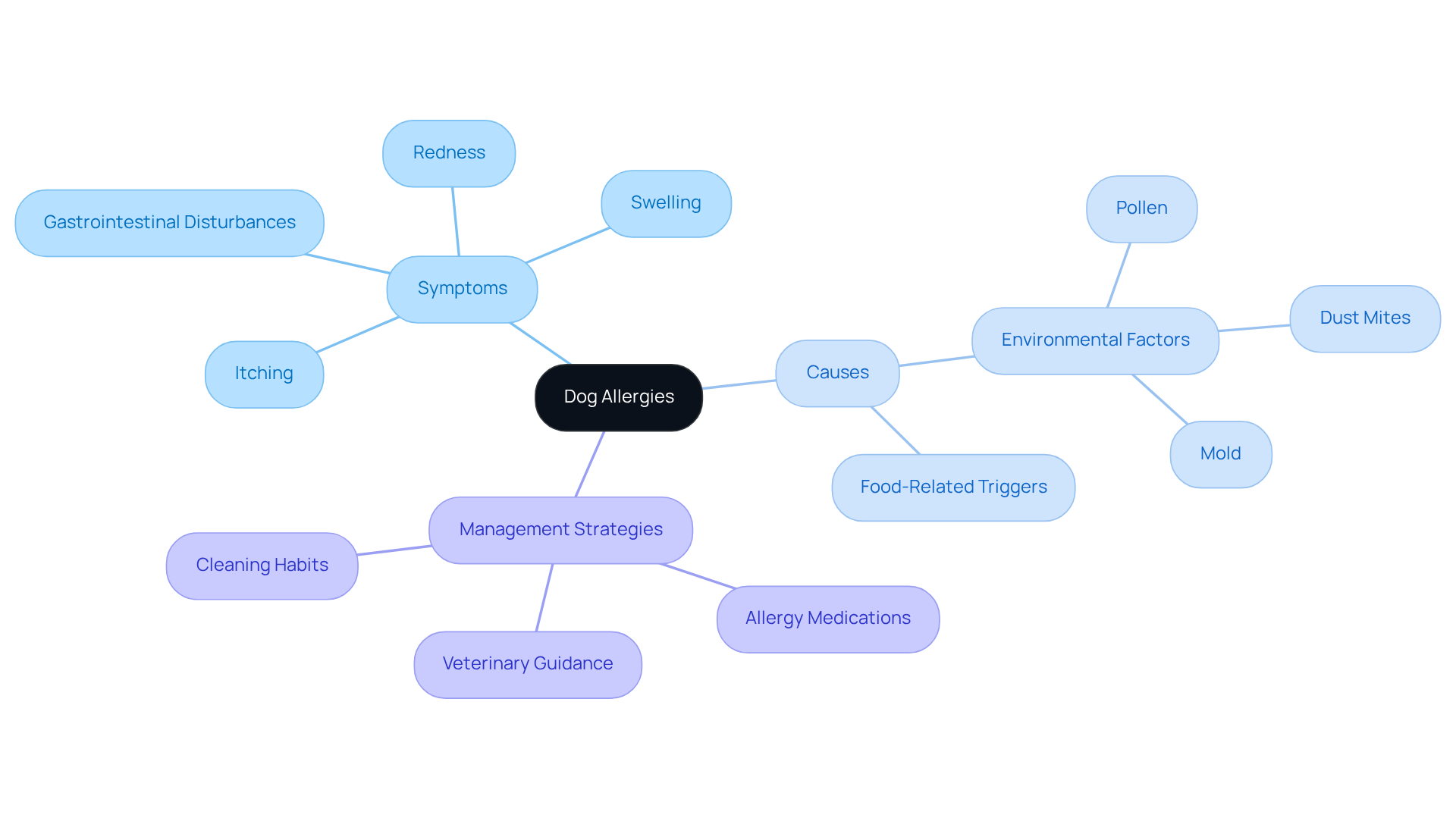Comparing Allergy Meds for Dogs: OTC vs. Prescription Options
Overview
This article thoughtfully compares over-the-counter (OTC) and prescription allergy medications for dogs, addressing the concerns many pet owners have about their furry family members’ health. OTC options, like Zyrtec, can effectively manage mild symptoms, providing a sense of relief for both pets and their owners. However, for more severe allergies, prescription medications such as Apoquel and Cytopoint offer targeted relief that can make a significant difference in your pet’s quality of life.
It’s crucial to consult with a veterinarian to ensure the best treatment outcomes for your beloved companions. By seeking professional guidance, you can navigate the options available and choose the most suitable path for your pet’s needs. Remember, your pet’s well-being is our priority, and together we can create a nurturing environment for them to thrive.
Introduction
Understanding the complexities of dog allergies is essential for any pet owner. These sensitivities can lead to discomfort and distress for your beloved companions. With a growing number of dogs affected by environmental and food-related allergens, the choice between over-the-counter (OTC) and prescription medications becomes increasingly critical.
This article delves into the benefits and drawbacks of each option, exploring how you can navigate the maze of allergy treatments to find the most effective solutions for your furry family members.
What factors should you consider when deciding between the convenience of OTC options and the targeted relief offered by prescription medications?
Understanding Dog Allergies: Symptoms and Causes
Dog sensitivities can present a variety of symptoms, such as itching, redness, swelling, and gastrointestinal disturbances. As a loving pet owner, it’s important to recognize that these sensitivities often stem from environmental factors like pollen, dust mites, and mold, as well as food-related triggers. It’s estimated that 10% to 20% of the global population experiences sensitivities to pets, with our beloved canines being a significant contributor. In the United States, up to 30% of people are allergic to pets, highlighting the widespread nature of these conditions. Seasonal sensitivities may lead to increased scratching and licking, while dietary intolerances can manifest as digestive upset. Identifying these signs is crucial for pet owners to assess when their furry family members may require allergy meds for dogs.
Recent studies reveal that allergic sensitization to dogs affects up to 25% of children and adults, emphasizing the need to understand these conditions. A notable case study shows that dog sensitivities are primarily triggered by proteins found in a dog’s dander, saliva, and urine, rather than the fur itself. This distinction is vital for effective management and treatment strategies. Veterinarians stress that identifying the underlying cause of allergies is essential for selecting the right treatment, including the appropriate allergy meds for dogs, whether it involves over-the-counter (OTC) options or prescription medications. Additionally, maintaining consistent cleaning habits, such as vacuuming and bathing your pets, is crucial for managing allergens effectively. By being attentive to your pets’ symptoms and potential allergens, you can take proactive steps to relieve discomfort and enhance their quality of life. Remember, your furry family members deserve a nurturing environment, and together, we can help them thrive.

Types of Allergy Medications: Over-the-Counter vs. Prescription
When it comes to caring for your furry family members, over-the-counter treatments can be a helpful option. Antihistamines like Benadryl (diphenhydramine), Zyrtec (cetirizine), and Claritin (loratadine) are commonly used to relieve mild to moderate hypersensitivity symptoms. These medications are easily accessible without a prescription, making them a convenient choice for pet owners. Zyrtec stands out as a budget-friendly option, with effects typically starting within 4-7 hours and peak relief often seen after 6-7 days. However, it’s important to note that while these OTC options are readily available, they may not provide sufficient relief for all canines, especially those facing severe allergies. Zyrtec is generally safe for long-term use, though some dogs may experience drowsiness.
For more severe allergic responses and long-term conditions, prescribed medications like oclacitinib and Cytopoint (lokivetmab) offer targeted relief. A Janus Kinase (JAK) inhibitor can provide rapid relief from itching and inflammation, often showing significant improvements within hours. However, these medications may suppress the immune system, increasing the risk of infections, and can lead to elevated liver enzymes and seizures in some cases. While prescription drugs are typically more expensive, they deliver focused relief tailored to your dog’s specific needs, making them a more effective option for chronic sensitivity issues. Notably, studies have shown that Apoquel therapy achieved a remarkable 100% reduction in systemic antimicrobial therapy over eight weeks, underscoring its effectiveness.
Veterinary experts often recommend prescription treatments for canines with serious sensitivities, as these options can lead to improved long-term outcomes. For example, dogs treated with oclacitinib have shown a significant reduction in dermatitis severity and a notable decrease in the need for additional antimicrobial therapies. This highlights the importance of consulting with a veterinarian to determine the best treatment plan based on your dog’s symptoms and overall health. In some cases, combining Apoquel and Zyrtec under veterinary supervision may be necessary for severe sensitivities, providing a more comprehensive approach to their care.

Evaluating Allergy Medications: Benefits and Drawbacks
As pet owners, we understand how concerning it can be to see your furry family members suffer from allergies and the importance of allergy meds for dogs. Over-the-counter (OTC) allergy meds for dogs are generally safe and can effectively manage mild allergies. However, it’s important to note that allergy meds for dogs may cause drowsiness or hyperactivity in some pets and might not be sufficient for more severe symptoms.
For targeted relief, prescription medications like Cytopoint can provide a compassionate solution. This medication is designed to alleviate itching and inflammation while presenting fewer side effects compared to long-term steroid use. Cytopoint works by suppressing the immune response that causes itching, typically showing results within just 24 hours. In fact, clinical studies reveal that approximately 66% of dogs treated with Apoquel showed improvement, although about 33% did not respond positively.
On the other hand, Cytopoint specifically targets proteins involved in allergic reactions. Long-term studies indicate that an impressive 87% of dogs maintained a low pruritus score over 12 months, and 93% of pet owners expressed satisfaction with the treatment. While both medications can be effective, they may come at a higher cost and require veterinary supervision.
It’s crucial to be aware that bone marrow suppression occurs in about 1% of pets using these medications, and common side effects include vomiting, diarrhea, and lethargy. Recognizing these advantages and disadvantages is essential when creating a care plan for your beloved companions. Additionally, monitoring protocols, such as checking a CBC/Chem6 before starting treatment, at three months, and then yearly, are vital for ensuring your pet’s health and well-being.
In the journey of caring for your pet, remember that you are not alone. At Adventure Den, we are here to support you and your furry family members every step of the way.
![]()
Guidelines for Safe Use: Dosage, Side Effects, and Veterinary Consultation
When it comes to administering allergy meds for dogs to your furry family members, it is crucial to follow the dosage guidelines provided by your veterinarian or indicated on the treatment label. For instance, the typical dosage for Benadryl is 2 to 4 milligrams per kilogram of body weight, administered two to three times a day. However, this can vary for each individual dog, and it’s essential to be mindful of their unique needs.
Overdosing can lead to serious side effects, including lethargy, vomiting, hyper-excitability, rapid heartbeat, and potentially seizures. This is why prescription medications should always be given under veterinary guidance, as they may cause side effects such as heightened vulnerability to infections and gastrointestinal distress. Regular veterinary consultations are not just a recommendation; they are a necessary step to monitor your dog’s response to treatment and adjust dosages as needed. This approach ensures that the treatment remains effective while minimizing risks.
Significantly, research shows that while Apoquel is effective for many canines, some may experience mild side effects like vomiting or diarrhea. This highlights the importance of careful observation and a nurturing environment for your pet. Moreover, senior dogs are at an increased risk for treatment errors, making veterinary supervision even more vital.
Did you know that medication errors affect over 1.3 million patients in America each year? This statistic underscores the importance of adhering to veterinary guidelines. By staying informed and engaged, you can help ensure that your beloved pet receives the best possible care, fostering their health and happiness.

Conclusion
Understanding the right approach to managing dog allergies can significantly enhance the quality of life for both pets and their owners. The choice between over-the-counter (OTC) and prescription allergy medications is not just about convenience; it involves evaluating the specific needs of your dog and the severity of their symptoms. Each option presents unique advantages and potential drawbacks that must be carefully considered.
Throughout this article, we have shared key insights regarding:
- The symptoms and causes of dog allergies
- The efficacy of various OTC and prescription medications
- The importance of veterinary consultation
OTC medications like Zyrtec and Benadryl can provide relief for mild allergies, while prescription options such as Apoquel and Cytopoint are designed for more severe cases, offering targeted treatment that can lead to significant improvements in your dog’s condition. It is essential to recognize that while OTC options are accessible, they may not suffice for all dogs, necessitating a thoughtful discussion with a veterinarian to tailor the best treatment plan.
Ultimately, the well-being of your furry family member hinges on informed decision-making and proactive care. As a caring pet owner, you are encouraged to remain vigilant about your dog’s health, recognizing allergy symptoms early and seeking appropriate treatment. By balancing the convenience of OTC medications with the specialized care offered by prescriptions, you can ensure your beloved pet receives the relief they deserve, fostering a happier and healthier life.
Frequently Asked Questions
What are the common symptoms of dog allergies?
Common symptoms of dog allergies include itching, redness, swelling, and gastrointestinal disturbances.
What causes dog allergies?
Dog allergies can stem from environmental factors such as pollen, dust mites, and mold, as well as food-related triggers.
How prevalent are pet allergies in the population?
It is estimated that 10% to 20% of the global population experiences sensitivities to pets, with up to 30% of people in the United States being allergic to pets.
How do seasonal sensitivities affect dogs?
Seasonal sensitivities may lead to increased scratching and licking in dogs.
What are dietary intolerances in dogs?
Dietary intolerances in dogs can manifest as digestive upset.
What triggers dog sensitivities?
Dog sensitivities are primarily triggered by proteins found in a dog’s dander, saliva, and urine, rather than the fur itself.
Why is it important to identify the underlying cause of allergies in dogs?
Identifying the underlying cause of allergies is essential for selecting the right treatment, including the appropriate allergy medications.
What types of allergy medications are available for dogs?
Allergy medications for dogs can include over-the-counter (OTC) options or prescription medications.
How can pet owners manage allergens effectively?
Pet owners can manage allergens effectively by maintaining consistent cleaning habits, such as vacuuming and bathing their pets.
What steps can pet owners take to improve their dog’s quality of life regarding allergies?
Pet owners can take proactive steps to relieve their dog’s discomfort by being attentive to symptoms and potential allergens, ensuring a nurturing environment for their furry family members.







